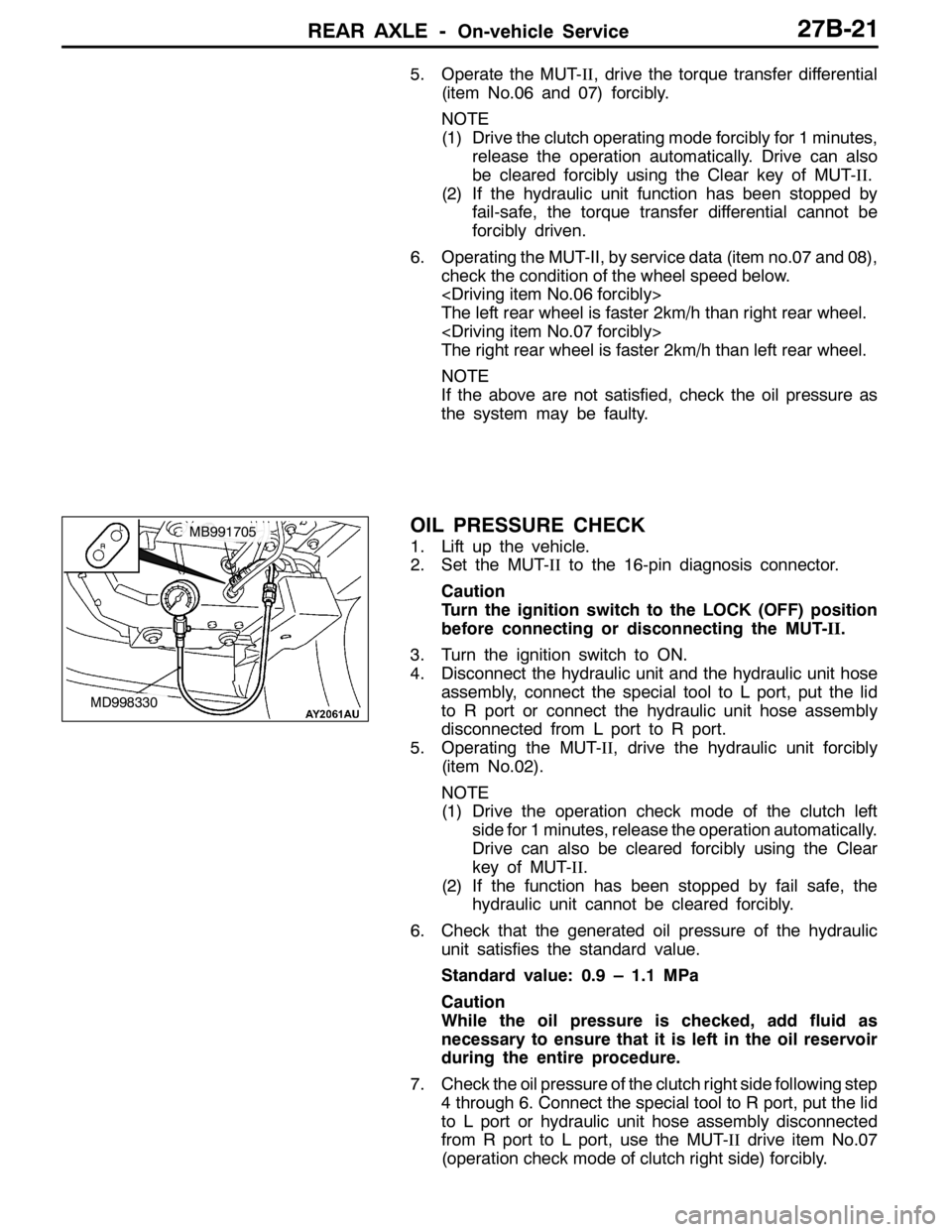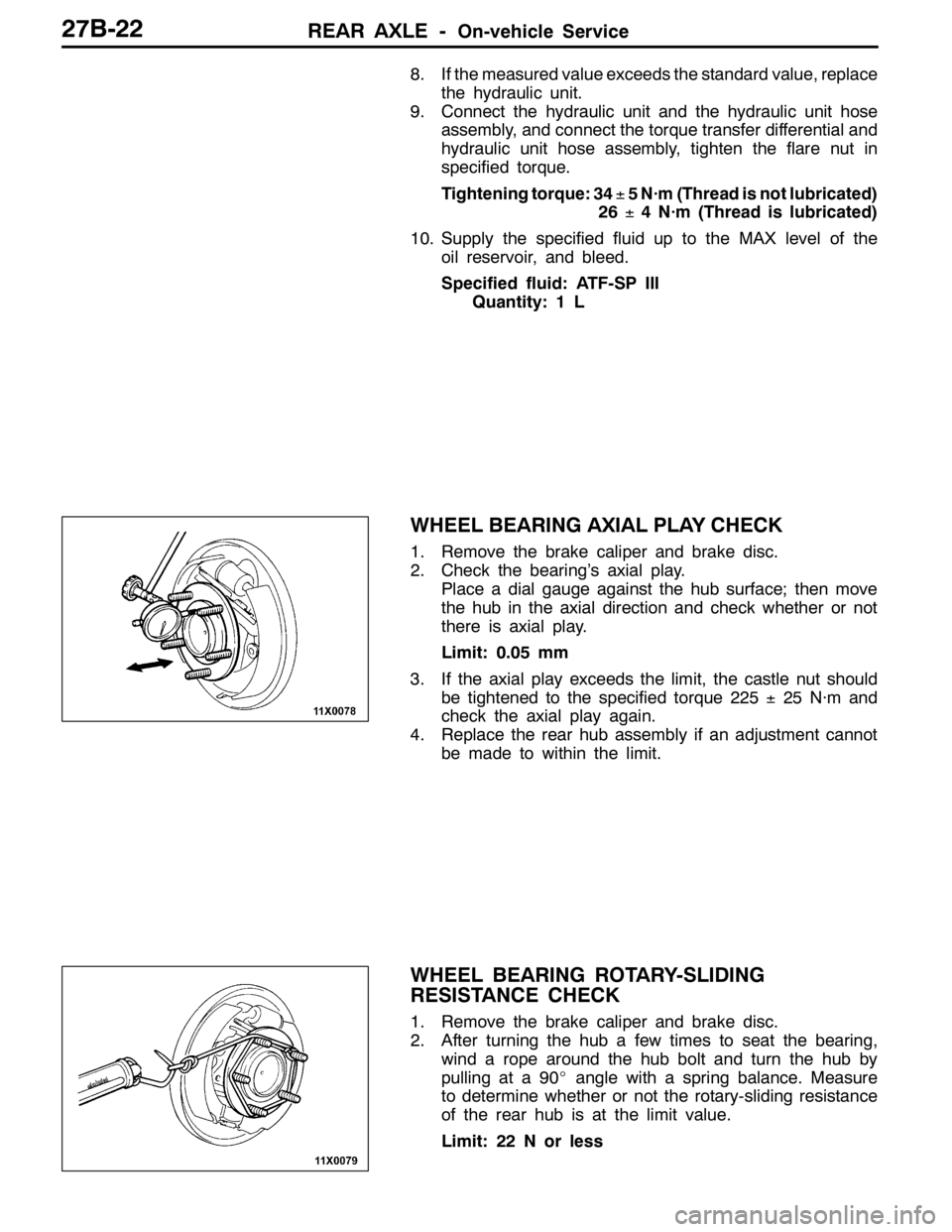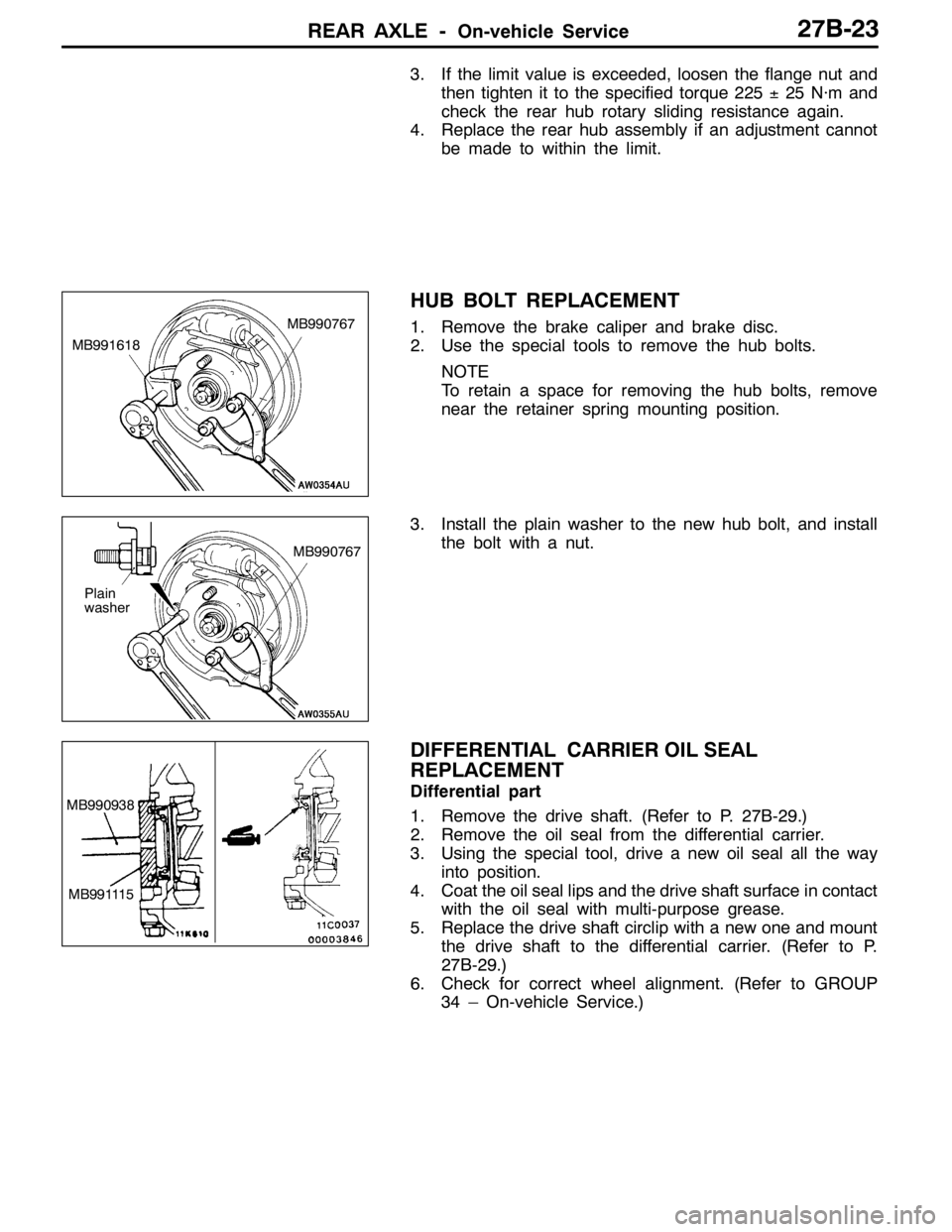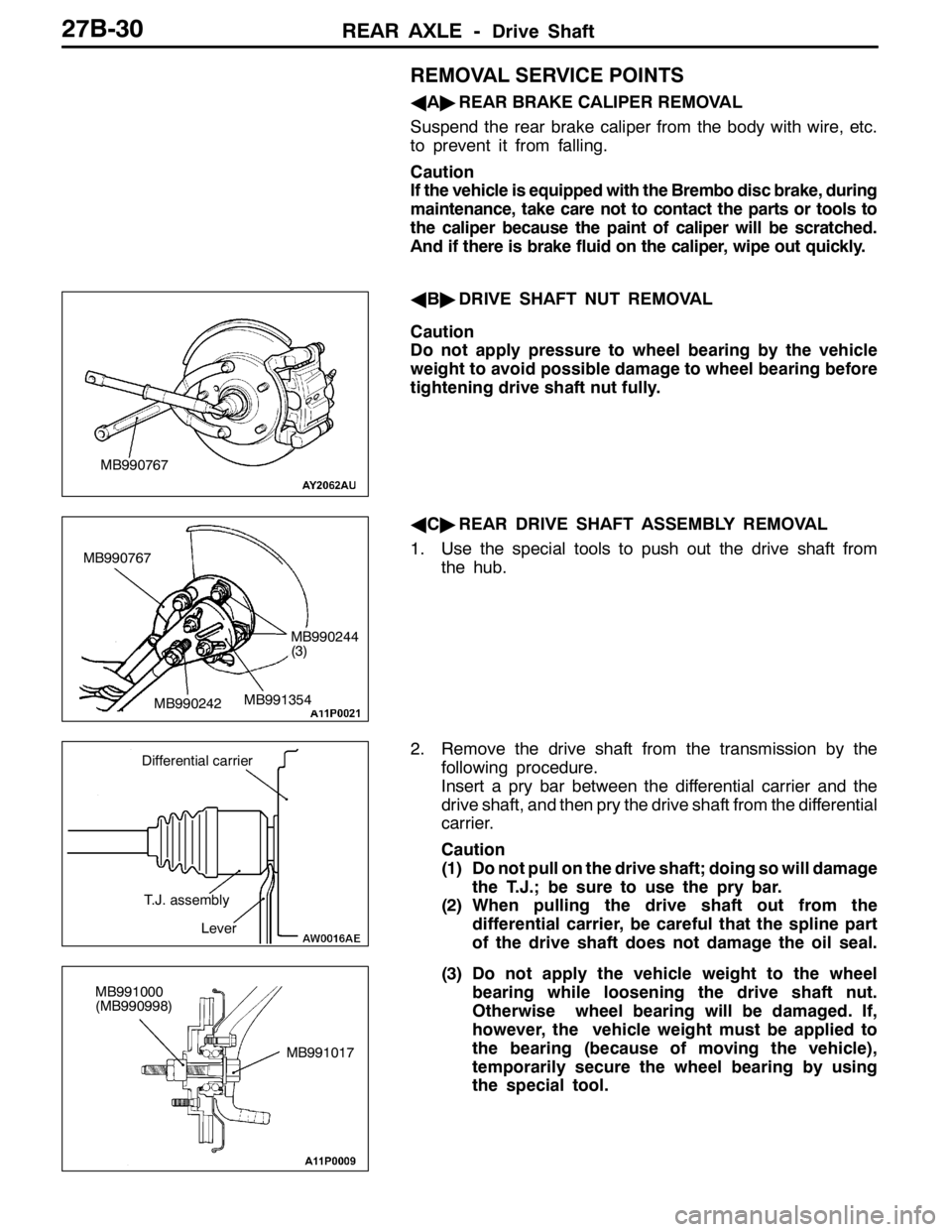Page 967 of 1449

REAR AXLE -On-vehicle Service27B-21
5. Operate the MUT-II, drive the torque transfer differential
(item No.06 and 07) forcibly.
NOTE
(1) Drive the clutch operating mode forcibly for 1 minutes,
release the operation automatically. Drive can also
be cleared forcibly using the Clear key of MUT-II.
(2) If the hydraulic unit function has been stopped by
fail-safe, the torque transfer differential cannot be
forcibly driven.
6. Operating the MUT-II, by service data (item no.07 and 08),
check the condition of the wheel speed below.
The left rear wheel is faster 2km/h than right rear wheel.
The right rear wheel is faster 2km/h than left rear wheel.
NOTE
If the above are not satisfied, check the oil pressure as
the system may be faulty.
OIL PRESSURE CHECK
1. Lift up the vehicle.
2. Set the MUT-IIto the 16-pin diagnosis connector.
Caution
Turn the ignition switch to the LOCK (OFF) position
before connecting or disconnecting the MUT-II.
3. Turn the ignition switch to ON.
4. Disconnect the hydraulic unit and the hydraulic unit hose
assembly, connect the special tool to L port, put the lid
to R port or connect the hydraulic unit hose assembly
disconnected from L port to R port.
5. Operating the MUT-II, drive the hydraulic unit forcibly
(item No.02).
NOTE
(1) Drive the operation check mode of the clutch left
side for 1 minutes, release the operation automatically.
Drive can also be cleared forcibly using the Clear
key of MUT-II.
(2) If the function has been stopped by fail safe, the
hydraulic unit cannot be cleared forcibly.
6. Check that the generated oil pressure of the hydraulic
unit satisfies the standard value.
Standard value: 0.9 – 1.1 MPa
Caution
While the oil pressure is checked, add fluid as
necessary to ensure that it is left in the oil reservoir
during the entire procedure.
7. Check the oil pressure of the clutch right side following step
4 through 6. Connect the special tool to R port, put the lid
to L port or hydraulic unit hose assembly disconnected
from R port to L port, use the MUT-IIdrive item No.07
(operation check mode of clutch right side) forcibly.
MD998330
MB991705
Page 968 of 1449

REAR AXLE -On-vehicle Service27B-22
8. If the measured value exceeds the standard value, replace
the hydraulic unit.
9. Connect the hydraulic unit and the hydraulic unit hose
assembly, and connect the torque transfer differential and
hydraulic unit hose assembly, tighten the flare nut in
specified torque.
Tightening torque: 34±5 N·m (Thread is not lubricated)
26±4 N·m (Thread is lubricated)
10. Supply the specified fluid up to the MAX level of the
oil reservoir, and bleed.
Specified fluid: ATF-SP III
Quantity: 1 L
WHEEL BEARING AXIAL PLAY CHECK
1. Remove the brake caliper and brake disc.
2. Check the bearing’s axial play.
Place a dial gauge against the hub surface; then move
the hub in the axial direction and check whether or not
there is axial play.
Limit: 0.05 mm
3. If the axial play exceeds the limit, the castle nut should
be tightened to the specified torque 225±25 N·m and
check the axial play again.
4. Replace the rear hub assembly if an adjustment cannot
be made to within the limit.
WHEEL BEARING ROTARY-SLIDING
RESISTANCE CHECK
1. Remove the brake caliper and brake disc.
2. After turning the hub a few times to seat the bearing,
wind a rope around the hub bolt and turn the hub by
pulling at a 90_angle with a spring balance. Measure
to determine whether or not the rotary-sliding resistance
of the rear hub is at the limit value.
Limit: 22 N or less
Page 969 of 1449

REAR AXLE -On-vehicle Service27B-23
3. If the limit value is exceeded, loosen the flange nut and
then tighten it to the specified torque 225±25 N·m and
check the rear hub rotary sliding resistance again.
4. Replace the rear hub assembly if an adjustment cannot
be made to within the limit.
HUB BOLT REPLACEMENT
1. Remove the brake caliper and brake disc.
2. Use the special tools to remove the hub bolts.
NOTE
To retain a space for removing the hub bolts, remove
near the retainer spring mounting position.
3. Install the plain washer to the new hub bolt, and install
the bolt with a nut.
DIFFERENTIAL CARRIER OIL SEAL
REPLACEMENT
Differential part
1. Remove the drive shaft. (Refer to P. 27B-29.)
2. Remove the oil seal from the differential carrier.
3. Using the special tool, drive a new oil seal all the way
into position.
4. Coat the oil seal lips and the drive shaft surface in contact
with the oil seal with multi-purpose grease.
5. Replace the drive shaft circlip with a new one and mount
the drive shaft to the differential carrier. (Refer to P.
27B-29.)
6. Check for correct wheel alignment. (Refer to GROUP
34 – On-vehicle Service.)
MB991618MB990767
Plain
washerMB990767
MB990938
MB991115
Page 970 of 1449

REAR AXLE -On-vehicle Service27B-24
Torque transfer mechanism part
1. Remove the drive shaft. (Refer to P. 27B-29.)
2. Remove the oil seal from the differential carrier.
3. Using the special tool, drive a new oil seal all the way
into position.
4. Coat the oil seal lips and the drive shaft surface in contact
with the oil seal with the specified grease.
Specified grease: Vaseline
5. Replace the drive shaft circlip with a new one and mount
the drive shaft to the differential carrier. (Refer to P.
27B-29.)
6. Check for correct wheel alignment. (Refer to GROUP
34 – On-vehicle Service.)
ACTION WHEN BATTERY RUNS OUT
When the engine is started using a booster cable where the
battery has completely run down and you attempt to start
the vehicle without waiting for the battery to recover a certain
charge, the engine can misfire and you just cannot start to
move it. In such cases, charge the battery sufficiently; or,
remove the AYC battery cable from the battery fuse assembly
to make AYC inactive before attempting to start the vehicles.
When the battery cable is removed, the ACD mode indicator
lamp lights up. After the battery has been recharged, fit the
battery cable back again and start the engine to ensure that
the ACD mode indicator lamp is off.
MD998829
MD998813 MD998812
Battery fuse assembly
Battery cable
for AYC
Page 976 of 1449

REAR AXLE -Drive Shaft27B-30
REMOVAL SERVICE POINTS
AA"REAR BRAKE CALIPER REMOVAL
Suspend the rear brake caliper from the body with wire, etc.
to prevent it from falling.
Caution
If the vehicle is equipped with the Brembo disc brake, during
maintenance, take care not to contact the parts or tools to
the caliper because the paint of caliper will be scratched.
And if there is brake fluid on the caliper, wipe out quickly.
AB"DRIVE SHAFT NUT REMOVAL
Caution
Do not apply pressure to wheel bearing by the vehicle
weight to avoid possible damage to wheel bearing before
tightening drive shaft nut fully.
AC"REAR DRIVE SHAFT ASSEMBLY REMOVAL
1. Use the special tools to push out the drive shaft from
the hub.
2. Remove the drive shaft from the transmission by the
following procedure.
Insert a pry bar between the differential carrier and the
drive shaft, and then pry the drive shaft from the differential
carrier.
Caution
(1) Do not pull on the drive shaft; doing so will damage
the T.J.; be sure to use the pry bar.
(2) When pulling the drive shaft out from the
differential carrier, be careful that the spline part
of the drive shaft does not damage the oil seal.
(3) Do not apply the vehicle weight to the wheel
bearing while loosening the drive shaft nut.
Otherwise wheel bearing will be damaged. If,
however, the vehicle weight must be applied to
the bearing (because of moving the vehicle),
temporarily secure the wheel bearing by using
the special tool.
MB990767
MB990767
MB990242MB991354
MB990244
(3)
Differential carrier
T.J. assembly
Lever
MB991017 MB991000
(MB990998)
Page 977 of 1449
REAR AXLE -Drive Shaft27B-31
(4) To prevent entry of foreign matter into the
differential carrier, use the special tool as a cover.
INSTALLATION SERVICE POINTS
"AADRIVE SHAFT INSTALLATION
Caution
When installing the drive shaft to the differential carrier,
be careful that the spline part of the drive shaft does not
damage the oil seal.
"BADRIVE SHAFT NUT INSTALLATION
1. Assemble the drive shaft washer in the illustrated direction.
2. Tighten the drive shaft nut fully with special tools.
Caution
Do not apply pressure to wheel bearing by the vehicle
weight to avoid possible damage to wheel bearing
before tightening drive shaft nut fully.
3. If the pin hole does not align with another, tighten the
drive shaft nut (less than 250 N
·m) and find the nearest
hole then bend the split pin to fit in.
MB991460
MB990767
225±25 N·m
Washer
Page 981 of 1449

REAR AXLE -Differential Carrier 27B-35
DIFFERENTIAL CARRIER
REMOVAL AND INSTALLATION
Pre-removal Operation
DDifferential Gear Oil Draining (Refer to P.27B-17.)
DLower Arm Assembly Removal (Refer to GROUP
34.)
DRear Stabilizer Removal (Refer to GROUP 34.)
DDrive Shaft Removal (Refer to P. 27B-29.)Post-installation Operation
DDrive Shaft Installation (Refer to P. 27B-29.)
DRear Stabilizer Installation (Refer to GROUP 34.)
DLower Arm Assembly Installation (Refer to GROUP
34.)
DDifferential Gear Oil Filling (Refer to P.27B-17.)
12
765
4 8 910
32�¶2N��m
2
3
3 3
3
76
9
120±10 N·m
88±10 N·m
69±9 N·m
88±10 N·m
88±10 N·m
88±10 N·m
120±10 N·m
120±10 N·m
120±10 N·m
69±9 N·m
88±10 N·m
Removal steps
AA"1. Propeller shaft connection (Refer to
GROUP 25.)
2. Toe control bar
3. Differential support member mount-
ing boots and nuts
AB""AA4. Rear crossmember and differential
carrier assembly5. Differential support member
6. Upper stopper
7. Lower stopper
8. Differential support arm
9. Differential mount bracket
10. Differential carrier assembly
Page 982 of 1449

REAR AXLE -Differential Carrier 27B-36
REMOVAL SERVICE POINTS
AA"PROPELLER SHAFT DISCONNECTION
Suspend the removed propeller shaft from the body with a
wire to prevent bending.
AB"REAR CROSSMEMBER AND DIFFERENTIAL
CARRIER ASSEMBLY REMOVAL
1. Using a jack, support the differential carrier from its
underside.
2. Remove the rear crossmember mounting bolts and
remove the differential carrier, where it is attached to
the rear crossmember, from the vehicle.
INSTALLATION SERVICE POINTS
"AAREAR CROSSMEMBER AND DIFFERENTIAL
CARRIER ASSEMBLY INSTALLATION
Tighten the rear crossmember mounting bolts in the numerical
order shown.
NOTE
To ensure both good installation accuracy and ease of
installation, the rear crossmember mounting holes have
different diameters between front and rear. This is the reason
for specifying the tightening sequence of the mounting bolts.
No.Bolt typeBolt size(thread
dia.×length)mm
1, 2, 3Flange bolt(with washer)12×105
4Bolt(with spring washer and
washer)12×152
5Flange bolt(with washer)12×70
5
Front of vehicle
1
3
442
3